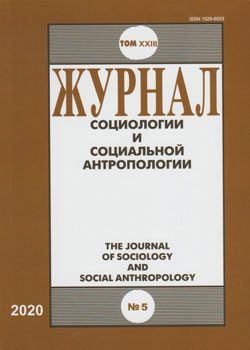Инвестиции времени в заботу о здоровье: оценка на основе выборочного социологического исследования
Аннотация
One of the indicators of the health’s value of for the population is data on the time and resources spent on maintaining good physical shape. Despite the long-standing interest of researchers in this topic, the question of which groups of the population most actively invest time in taking care of their health has not been raised before. The purpose of this work is to analyze the features of time investment in health care that are characteristic of the Russian population in the context of certain socio-demographic categories. The information base was microdata of a sample observation of the time budgets of the Russian population for 2019. It is established that temporarily or long-term disabled people spend the greatest amount of time taking care of their health, and young students — the least. The time spent on health care varies significantly in groups of respondents with different income levels and working week duration. It is shown that working respondents increase the duration of individual health care practices on weekends, but their medical activity remains almost unchanged. In the final part of the article, recommendations are formulated aimed at improving the methods of conducting preventive and educational work on health-saving problems with the population of different socio-demographic groups. In the future, it is planned to assess the impact of social, economic and demographic factors on the investment of time in health by working individuals.
Литература
Anand P., Ben-Shalom Y. (2014) How Do Working-Age People with Disabilities Spend Their Time? New Evidence from the American Time Use Survey. Demography, 51: 1977–1998 https://doi.org/10.1007/s13524-014-0336-3.
Antonenko V.V., Antonov G.V. (2019) Investicii rossijskih domohozjajstv v chelovecheskij kapital detej: mezhpokolennyj analiz [Investment of Russian households in the human capital of children: an intergenerational analysis]. Ekonomicheskiy analiz: teoriya i praktika [Economic Analysis: Theory and Practice], 11(494): 2059–2077 (in Russian).
Antonenko V.V., Antonov G.V., Laktyukhina E.G. (2014) Investicii v zdorovye kak element chelovecheskogo kapitala individa: na primere molodezhi Volgogradskoy oblasti [Health investments as element of individual human capital: by the example of Volgograd region youth]. Almanakh sovremennoj nauki i obrazovaniya [Almanac of Modern Science and Education], 7(85): 18–22 (in Russian).
Bonke J., Greve J. (2012) Children’s health-related life-styles: how parental child care affects them. Review of Economics of the Household, 10: 557–572. https://doi.org/10.1007/s11150-012-9157-6.
Du J., Yagihashi T. (2017) Health capital investment and time spent on health-related activities. Review of Economics of the Household, 15: 1215–1248. https://doi.org/10.1007/s11150-017-9378-9.
Grossman M. (1972) On the Concept of Health Capital and the Demand for Health. Journal of Political Economy, 80(2): 223–255.
Gruzdeva M.A., Korolenko A.V. (2018) Povedencheskie faktory sokhranenija zdorovya molodezhi [Behavioral factors which can influence preservation of young people's health]. Analiz riska zdorovyu [Health Risk Analysis], 2: 41–51 (in Russian). https://doi.org/10.21668/health.risk/2018.2.05.
Jowsey T., Yen L., Mathews P.W. (2012) Time spent on health related activities associated with chronic illness: a scoping literature review. BMC Public Health, 12(1044). https://doi.org/10.1186/1471-2458-12-1044.
Jowsey T., McRae I., Gillespie J. et al. (2013) Time to care? Health of informal older carers and time spent on health related activities: an Australian survey. BMC Public Health, 13(374). https://doi.org/10.1186/1471-2458-13-374.
Kuznecova S.N., Romanovskaja E.V., Pasechnik A.S., Egorova M.I. (2019) Investicii v zdorov'e rabotnikov kak sposob povyshenija jeffektivnosti organizacii [Investicii v zdorov'e rabotnikov kak sposob povyshenija jeffektivnosti organizacii]. Upravlencheskiy uchet [Upravlencheskij uchet], 1: 4–11 (in Russian).
Liu Y., Wang X., Zhou S. et al. (2020) The association between spatial access to physical activity facilities within home and workplace neighborhoods and time spent on physical activities: evidence from Guangzhou, China. International Journal of Health Geographics, 19(22). https://doi.org/10.1186/s12942-020-00216-2.
Miller J.E., Nugent C.N., Russell L.B. (2016) How Much Time Do Families Spend on the Health Care of Children with Diabetes? Diabetes Therapy, 7: 497–509. https://doi.org/10.1007/s13300-016-0181-z.
Ovod A.I. (2018) Smertnost' kak social'nyj indikator jeffektivnosti investicij v zdravoohranenie [Mortality as a social indicator of the effectiveness of investments in healthcare]. Azimut nauchnykh issledovaniy: ekonomika i upravlenie [Azimuth of scientific research: Economics and management], 3(24): 217–220 (in Russian).
Rozmainsky I.V., Osipova V.A. (2020) Jekonomicheskij analiz kurenija kak negativnoj investicii v kapital zdorov'ja [Economic analysis of smoking as a negative investment in health capital]. Terra Economicus, 18(1):58–80 (in Russian).
Saburova L.A. (2015) Zdorovye kak simvolicheskiy kapital: osobennosti kapitalizatsii i social'nogo obmena v sfere zdorovya [Health as symbolic capital: peculiarities of capitalization and social exchange in health]. Nauchnyy ezhegodnik Instituta filosofii i prava Uralskogo otdeleniya Rossiyskoy akademii nauk [Research Yearbook, Institute of Philosophy and Law, Ural Branch of the Russian Academy of Sciences], 15(2): 48–60 (in Russian).
Shabunova A.A. (2014) Obshhestvennoe razvitie i demograficheskie vyzovy sovremennosti [Social development and modern demographic challenges]. Problemy razvitija territorii [Problems of territory's development], 2(70): 7–17 (in Russian).
Veretennikova I.I., Kostina N.A. (2011) Metodicheskie aspekty opredelenija jeffektivnosti investicij, napravljaemyh na uluchshenie kachestva zhizni i vozrastanie chelovecheskogo capital [Methodological aspects of determining the effectiveness of investments aimed at improving the quality of life and increasing human capital]. Vestnik Belgorodskogo Universiteta kooperatsii, ekonomiki i prava [Herald of the Belgorod University of Cooperation, Economics and Law], 1(37): 59–64 (in Russian).

